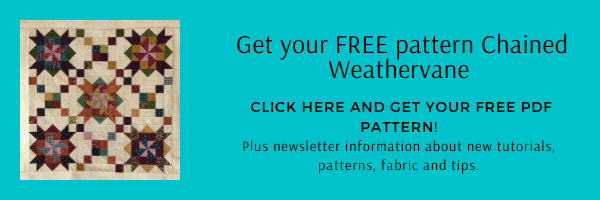A Traditional Wheel of Fortune Quilt Block Tutorial
The center of this Wheel of Fortune block is a great place to showcase a special fabric or embroidery design. This version also creates a secondary diamond shape in between blocks. The block also goes by the names Rising Sun, Wheel of Luck, and Buttons and Bows. And other blocks go by this name - confusing! Let's get started!

Fabric Requirements for a 12" Finished Wheel of Fortune Quilt Block:
- Light/Ivory: 1 - 5" squares*, 2 - 4" squares, and 8 - 2" x 3.5" rectangles
- Medium/Green: 2 - 5" squares*, and 8 - 2" squares
- Medium/Focal: 1 - 6.5" square
- Dark/Brown: 1 - 5" square*, and 4 - 2" squares
- Dark/Red: 2 - 4" squares
* The picture is incorrect in the number of squares needed. You'd think by this time, I'd be able to figure out how many squares are needed!

Sewing Directions:
Center Unit:
Step 1:
Basically all you are doing for this unit is "snowballing" every corner of the Medium/Focal square with the Dark/Brown 2" squares. You can find the tutorial for making a basic Snowball block at https://fabric406.com/blogs/fabric406-blog/how-to-sew-a-basic-snowball-block. In the picture below you can see each step starting at the top left corner and moving clockwise around the square.
After you've trimmed the seam allowance, press the seam allowance toward the center of the unit.

Half Square Triangle Units:
Step 2:
Using the Light/Ivory 4" squares and Dark/Red 4" squares, make four Half Square Triangles like the ones shown in the picture below. You will find the tutorial for making Half Square Triangles at https://fabric406.com/blogs/fabric406-blog/how-to-sew-a-basic-half-square-triangle-block. Trim/square up the units to 3.5" square.

Hourglass Units:
You can find more detailed steps for these units in my tutorial for making a basic Hourglass block which can be found at https://fabric406.com/blogs/fabric406-blog/how-to-sew-a-basic-hourglass-or-quarter-square-triangle-block. The units you'll be making for this block are three-colored.
Step 3:
Using the Light/Ivory 5" square, the two Medium/Green 5" squares, and the Dark/Brown 5" square, make Half Square Triangle patches as shown in the picture below. Press the seam allowance toward the Medium/Green fabric.

Step 4:
Using the Step 3 units, make four Hourglass units as shown below. You can see that I've pressed my seam allowance using the twirl method. Trim/square up the units to 3.5" squares.

Step 5:
Using four Light/Ivory 2" x 3.5" rectangles and Medium/Green 2" squares sew together four of the units shown in the picture below. First mark a diagonal line from corner to corner on the back of the 2" square and sew to a rectangle (top image). Match up the corners and press (2nd image). Trim off the excess seam allowance (3rd image). Finished unit (bottom image).

Step 6:
Repeat Step 5 with the remaining Light/Ivory rectangles and Medium/Green 2" squares only changing the orientation of the Medium/Green square as shown in the picture below.

Step 7:
Here you can see the completed patches - 4 of each orientation.

Step 8:
Match up a Step 4 Hourglass patch, a Step 5 patch, and a Step 6 patch as shown in the top image below. Sew the patches together (middle image). Press the seam allowances away from the Hourglass patch (bottom image). Repeat for a total of four units.

Putting It All Together:
Step 9:
Lay out the Center unit, the four Half Square Triangle units, and the four Step 8 units as shown in the picture below.

Step 10:
Sew the units into three rows as shown below.

Step 11:
Press the seam allowances away from the Step 8 units as shown in the picture below.

Step 12:
Sew the three rows together and ...

Step 13:
Press the seam allowances toward the center of the block as shown below. You're done!

Here's an example of the traditional two-color block. You know me - I had to mix it up!

Layout Options:
Here's the standard 4 x 4 layout. I like the secondary design that appears with the diamonds.

Here's that same layout but with sashing and cornerstones. Also pretty!

Here's an on point layout.

Here's another on point layout but with setting triangles so you don't have to make crazy half and quarter blocks.

Here's an example of using a 6-Grid Chain block as an alternating block.

For this example of an alternating block I used an 8-Grid Chain block. Striking!

Conclusion:
While this wasn't a super easy block to sew together, I did enjoy it. I was happy that my seams matched up pretty good so that I didn't loose points. It is a beautiful star block.
I hope you've enjoyed this quilt block tutorial. If you liked this post and want to see more quilting tutorials like this, simply click here to sign up for my newsletter and also receive a free PDF.
Happy Quilting!
Elaine
P.S. To print a PDF of this tutorial, check out the free app at https://www.printfriendly.com/.
P.P.S. To figure out yardage for a quilt, check out this post: https://fabric406.com/blogs/fabric406-blog/how-much-fabric-do-i-need
